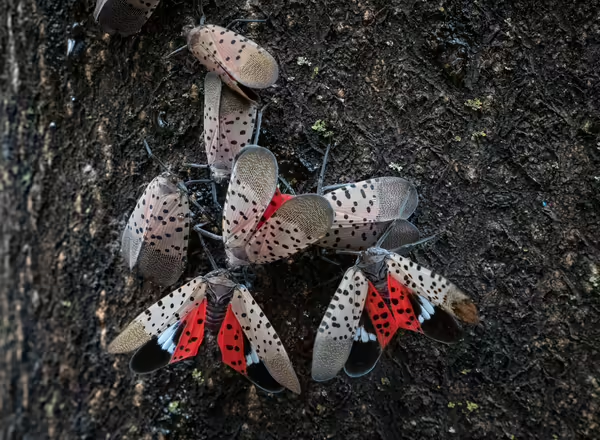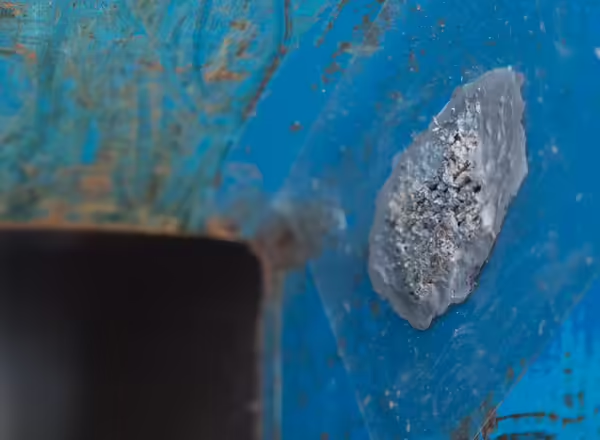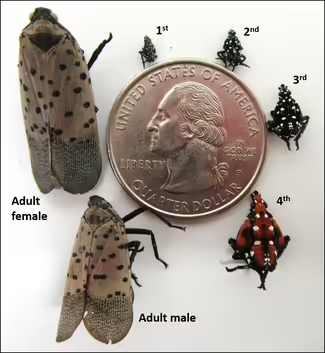
Spotted lanternfly (Lycorma delicatula) is a newer invasive pest in the United States that has recently been discovered in Illinois. They will feed on a wide range of woody plants, including fruit, ornamental, and woody trees. There is no need to panic, and they do not pose a threat to humans or animals, but you should be on the lookout for them.
What do they look like?
Adult spotted lanternflies are about 1 inch long. The front pair of wings are gray with black spots, and the tips of the front wings have speckled bands. The back pair of wings are red with black spots and a white band. Their heads and legs are black, and their abdomens are yellow with black bands.
The young nymphs (immatures) are black with white spots (1-3 instar). The last immature stage (4th instar) is red and black with white spots.


Why the concern?
Both nymphs and adults suck sap from stems, branches, and trunks. When large numbers of these insects start feeding on plants, it can reduce the vigor of the plants. Their feeding can also cause dieback on branches. The damage they cause while feeding (they have a piercing-sucking mouthpart) also creates an opening for pathogens to get into plants and cause disease.
In addition to their feeding damage, spotted lanternflies produce a lot of honeydew (a sticky, sugary substance excreted/pooped out by some insects). Sooty mold may then start to grow on this honeydew. While sooty mold does not feed on the plant itself, it can block light from reaching the leaves and reduce photosynthesis, further weakening the plant.
Their preferred host is tree of heaven, which wouldn’t necessarily be bad if they were the only plants they fed on since these trees can be invasive themselves. Unfortunately for us, spotted lanternflies will feed on over 100 different species of woody plants (trees and vines). Some of the other plants that spotted lanternflies will feed on include some economically important plants like grapes, hops, apples, stone fruit, black cherry, maples, tulip poplar, walnut, and willow. Fortunately, researchers at Penn State University have found that spotted lanternflies may not damage forest or ornamental trees as much as previously feared.
Where did they come from?
Spotted lanternflies are native to China, India, and Vietnam. They were likely introduced into the U.S. on a shipment of stone in 2012. Like many other invasive insects, they weren’t found immediately. They were first discovered in 2014 in Berks County, Pennsylvania. Since that time, they have spread across the mid-Atalantic and into the midwestern US.
In 2019, researchers with the USDA did some modeling to see what parts of the United States had a suitable environment for spotted lanternfly. Unfortunately, most of Illinois has a highly suitable environment for spotted lanternfly.

Life cycle
There is one generation of spotted lanternflies each year. Spotted lanternflies will overwinter in the egg stage, and the nymphs will hatch in spring and early summer and begin feeding. They will go through four instars (stages) before developing into adults, usually in late July. The adults can often be found in large groups on tree of heaven & grapes but will disperse when it comes time to lay eggs.
Females will begin to lay eggs in September and can continue laying them until late November or early December. They will lay masses of 30- 50 eggs on various surfaces such as tree bark, stones, metal, and outdoor furniture and then cover them with a gray, waxy coating. It is believed that each female will lay at least two of these masses. As time goes on, the waxy coating may begin to crack and look like dried mud. The eggs will then start to hatch in May.
Spread
Both the nymphs and adults are capable of jumping 6 to 9 feet. The adults can also fly short distances, although they often prefer to jump and glide. Individual insects are capable of traveling 3-4 miles on their own. However, like many of our other invasive insects, much of their long-distance spread is due to humans. This most commonly happens by moving infested plant material or items that contain egg masses.
If you believe you have found a spotted lanternfly in Illinois, send a photo and a detailed email to lanternfly@illinois.edu and include where, when, and the specifics of the location. In addition, contact the Illinois Department of Agriculture (IDOA) at (815) 787-5476. The IDOA recommends that after reporting sightings, remove and destroy spotted lanternflies by crushing nymphs and adults and scraping egg masses into a container with rubbing alcohol.
Learn more about Illinois invasive species.
Good Growing Tip: According to the USDA, spotted lanternflies are the easiest to spot at dusk or during the night as they move up and down the trunks of plants. During the day, they will often cluster near the base of the plant, making it hard to find them.
References and More Information
- Hoover, Kelli, Lidiia Iavorivska, Emily K Lavely, Osariyekemwen Uyi, Brian Walsh, Emelie Swackhamer, Anne Johnson, and David M Eissenstat. 2023. “Effects of Long-Term Feeding by Spotted Lanternfly (Hemiptera: Fulgoridae) on Ecophysiology of Common Hardwood Host Trees.” Environmental Entomology, August.
- Inaoka, Mirai, Nicholas Seiter, Kelly Estes, and Kacie Athey. 2021. “Identification and Biology of Spotted Lanternfly.” University of Illinois Extension. Accessed May 17, 2021.
- Simisky, Tawny. “Spotted Lanternfly.” Center for Agriculture, Food and the Environment. Accessed May 17, 2021.
- “Spotted Lanternfly - Biology: Life Cycle, Identification, and Dispersion.” Biology: Life Cycle, Identification, and Dispersion | New York State Integrated Pest Management. Accessed May 17, 2021.
- Wakie, Tewodros T, Lisa G Neven, Wee L Yee, and Zhaozhi Lu. “The Establishment Risk of Lycorma Delicatula (Hemiptera: Fulgoridae) in the United States and Globally.” Journal of Economic Entomology, October 3, 2019.
Photo Credits
Adult: "20180830-APHIS-LSC-1509" (Public Domain) by USDAgov
Nymphs: "20180716-ARS-SRA-d4016-05" (Public Domain) by USDAgov
Egg mass: "20180828-APHIS-LSC-0931" (Public Domain) by USDAgov
Life stages: "SLF life stages with quarter Andrew Dech" (Public Domain) by USDAgov
Want to get notified when new Good Growing posts are available? SIGN ME UP!
MEET THE AUTHOR
Ken Johnson is a Horticulture Educator with University of Illinois Extension, serving Calhoun, Cass, Greene, Morgan, and Scott counties since 2013. Ken provides horticulture programming with an emphasis on fruit and vegetable production, pest management, and beneficial insects. Through his programming, he aims to increase backyard food production and foster a greater appreciation of insects.
